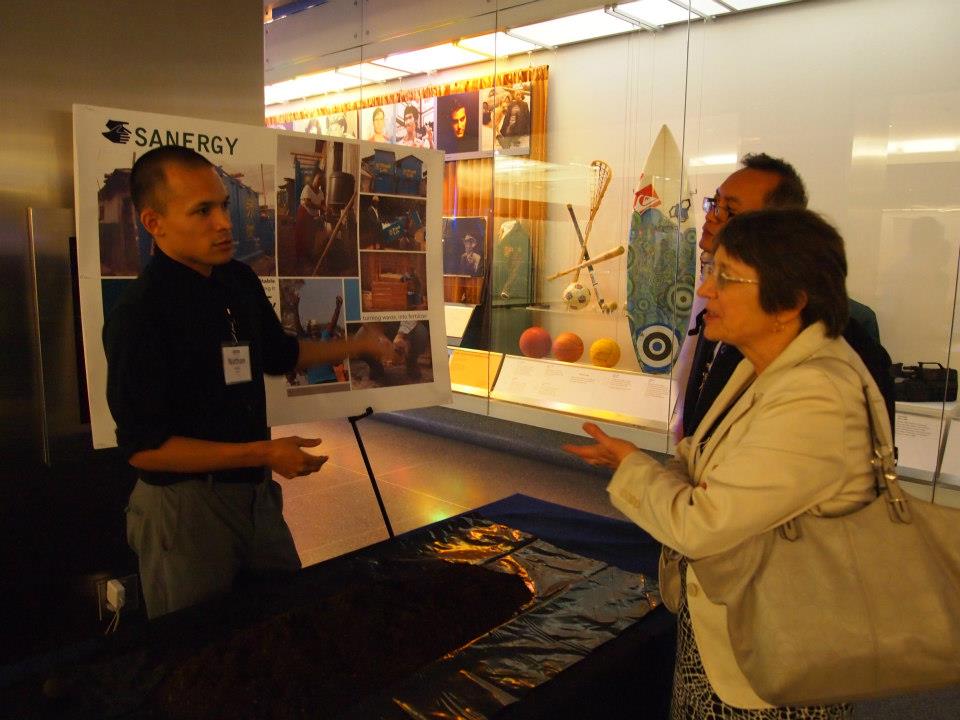At NCIIA’s Open Conference, a Shift Toward Responsible Startups: Student, faculty teams are increasingly addressing poverty
Last week the Lemelson Center for the Study of Invention and Innovation in the Smithsonian’s National Museum of American History was teeming with energy and excitement. Fourteen entrepreneurship teams, or “E-Teams” as we call them, from universities across the nation presented cutting-edge innovations at the National Collegiate Inventors and Innovators Alliance (NCIIA)’s Open Minds Exhibition, a highlight of the 17th annual NCIIA Open Conference.
Just a few of the presenters included:
- Oklahoma State University’s CleanNG LLC, recent winners of the Village Capital Venture Well peer-investment program, presented a new natural gas fuel storage system that allows more fuel to be stored in a smaller space.

- Penn State’s HESE Affordable Greenhouses demonstrated their affordable, easy-to-build greenhouse kits designed for small farmers in Africa.

- MIT’s Sanergy, a micro-franchised network of low-cost sanitation centers designed specifically for urban slums, stood in front of a table piled with high-quality organic fertilizer, a byproduct of the collected waste. As people passed by, presenter and Sanergy product developer Nathan Cooke, quipped, “hey, do you want to touch poop?!” (Read a NextBillion post on Sanergy).

The full list of student E-Teams can be found here.
Since 1995 NCIIA has been supporting efforts of students and faculty to invent, innovate and create impact with breakthrough technologies. The event is one of the key conferences on technology entrepreneurship in higher education. More recently, NCIIA’s support of E-Teams has shifted significantly toward projects whose primary focus is on addressing poverty. This shift is based greatly on the demand by faculty and students for this type of support. The growing trend led to the creation of NCIIA’s Sustainable Vision program. Launched in 2012, the Sustainable Vision connect program is an international community of faculty who seek to address global challenges through technology and market-based innovation.
For the second year in a row, we organized a half-day Sustainable Vision Connect pre-conference workshop on March 21, followed by the Open Minds Exhibition a day later. Thinking we might get 20 or 30 like-minded people, we put together an “un-panel” session focused on educational program models and an impact investors. We were blown away when we quickly reached nearly 90 registrations and had to cap participation. Clearly, there is interest in the topic and in bringing faculty together to discuss challenges in this space as well as sharing lessons learned.
NCIIA’s work with the Sustainable Vision community has recently led to an exciting opportunity to work with the USAID Grand Challenges program, and in particular the Saving Lives at Birth Grand Challenge.The challenge is a call for groundbreaking prevention and treatment approaches for pregnant women and newborns in the high-risk period following birth, especially the first 48 hours. This program is targeting poor, low-resource communities across the globe. As Global Training Programs manager, it is my job to oversee this training and to assess whether this approach is working and is, as anticipated, a necessary skill for the innovators in this portfolio. The answer is unequivocally “yes.”
Based on the NCIIA Venture Lab, the Xcelerator training program enables well-designed pathways to scale to help avoid some common pitfalls to reaching impact at scale. The inaugural Xcelerator training program, which took place in Arusha, Tanzania from Jan. 18 to 21, taught a dozen Saving Lives at Birth teams a methodology called Strategy Mapping — a simple process that enabled them to rapidly convey a working hypothesis of how an idea will progress toward a solution. In an elegant, easy-to-construct visual format, Strategy Mapping can clarify a range of innovation pathways, including: venture creation; delivery of solutions such as a new product or process; and the formation of an alternative approach to experiential training.
These aren’t novel concepts to social entrepreneurs — mapping a strategy, articulating a value proposition and conducting market research — these are all basic notions with which all entrepreneurs are familiar. What NCIIA is doing that is new and different and frankly, cutting edge, is working through these concepts with engineers. And, in the case of the USAID Xcelerator training program, classic “international development” staff are now integrating core concepts of developing a for-profit business to vastly improve upon their service demand and delivery models.
The concepts do translate, and the opportunity for cross-pollination is limitless.
Laura Sampath is NCIIA’s Global Training Programs manager, overseeing the planning and development of global venture development workshops.
- Categories
- Education, Energy, Health Care
- Tags
- research
